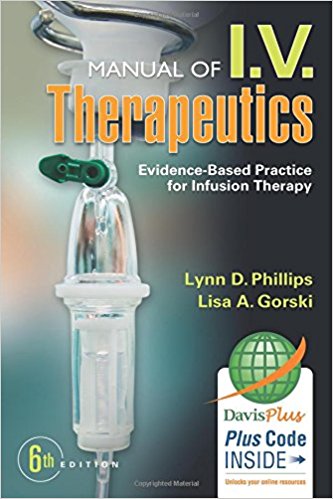I.V. Therapeutics Evidence Based Practice for Infusion Therapy 6th Edition by Lynn Dianne Phillips, Lisa Gorski – Test Bank
Original price was: $55.00.$20.00Current price is: $20.00.
I.V. Therapeutics: Evidence Based Practice for Infusion Therapy, 6th Edition by Lynn Dianne Phillips and Lisa Gorski is an essential resource for nurses who are responsible for administering I.V. therapy. The book provides evidence-based guidelines for I.V. therapy and includes a comprehensive review of the most current I.V.-related research.
In addition, the authors offer practical tips for I.V. insertion, management, and troubleshooting, making it an invaluable resource for both novice and experienced I.V. therapists alike. Whether you are looking for guidance on I.V. insertion techniques or need a refresher on the latest I.V.-related research, I.V. Therapeutics is the perfect resource for you.
Digital item No Waiting Time Instant Download
Description
I.V. Therapeutics Evidence-Based Practice for Infusion Therapy 6th Edition by Lynn Dianne Phillips, Lisa Gorski – Test Bank
Multiple Choice
Identify the choice that best completes the statement or answers the question.
____ 1. A nurse administers a parenteral solution to a client that contains portions of electrolytes, similar to plasma, as well as bicarbonate. The nurse is administering a(n):
|
a. |
hypotonic solution. |
|
b. |
isotonic solution. |
|
c. |
balanced solution. |
|
d. |
hypertonic solution. |
____ 2. A client presents in an emergency department and is diagnosed with fluid volume deficit. A nurse begins I.V. therapy per a physician’s order to replace the client’s lost fluids. Which hypotonic I.V. solution should the nurse anticipate being ordered for this client?
|
a. |
0.45% sodium chloride |
|
b. |
5% dextrose in water |
|
c. |
10% dextrose in water |
|
d. |
5% dextrose in 0.9% sodium chloride |
____ 3. An emergency department nurse is administering a colloidal I.V. solution to a client diagnosed with hypovolemia. Which solution, administered by the nurse, is considered a colloid solution?
|
a. |
Lactated Ringer’s |
|
b. |
Albumin |
|
c. |
5% dextrose in water |
|
d. |
5% dextrose in 0.45% sodium chloride |
____ 4. A nurse is preparing to begin fluid replacement therapy on an older adult, dehydrated client. Before a client is started on replacement therapy, which physiological function should be assessed?
|
a. |
Respiratory function |
|
b. |
Renal function |
|
c. |
Endocrine function |
|
d. |
Adrenal function |
____ 5. A nurse prepares to administer a blood transfusion to a client. Which I.V. solution is the only acceptable solution for the nurse to use to prime the administration set before administering blood?
|
a. |
Lactated Ringer’s solution |
|
b. |
5% dextrose in water |
|
c. |
0.9% sodium chloride |
|
d. |
5% dextrose and 0.45% sodium chloride |
____ 6. A pediatric nurse is preparing to administer a hypotonic I.V. solution to a child experiencing profound dehydration. Which solution would be considered a hydrating solution?
|
a. |
5% dextrose in water |
|
b. |
Lactated Ringer’s solution |
|
c. |
10% dextrose in water |
|
d. |
5% dextrose and 0.45% sodium chloride |
Chapter 4: Parenteral Solutions
Answer Section
MULTIPLE CHOICE
1.ANS:C
The nurse is administering a balanced solution. Hypotonic, isotonic, and hypertonic solutions refer only to those solutions whose osmolarity is, respectively, less than, equal to, or greater than that of plasma—not to their electrolyte or ionic contents.
PTS: 1 KEY: Cognitive Level: Analysis
2. ANS:A
The solution of 0.45% sodium chloride is hypotonic and has an osmolarity of 155. It is one of the only hypotonic solutions used in clinical practice. The range for hypotonic solutions is below 250 mOsm. Five percent dextrose in water has an osmolarity of 252 mOsm and is isotonic; 10% dextrose in water has an osmolarity of 505 mOsm and is hypertonic; 5% dextrose and 0.9% sodium chloride combined has an osmolarity of 560 mOsm and is hypertonic.
PTS: 1 KEY: Cognitive Level: Application
3. ANS:B
Albumin is a natural plasma protein prepared from donor plasma. Colloid solutions contain protein or starch molecules that remain distributed in the extracellular space and do not form a “true” solution.
PTS: 1 KEY: Cognitive Level: Application
4. ANS:B
The first concern for a client requiring replacement is whether the kidneys are functioning well enough to permit the therapy.
PTS: 1 KEY: Cognitive Level: Application
5. ANS:C
Saline solutions are the only solution to be used with any blood product. Dextrose solutions cause hemolysis of cells. Lactated Ringer’s solutions contain calcium ions that can also hemolyze the blood cells.
Reference: Roback, J. D., Combs, M. R., & Grossman, B. et al. (2008). Technical manual (16th ed.). MD: American Association of Blood Banks.
PTS: 1 KEY: Cognitive Level: Application
6. ANS:D
Solutions that contain dextrose and hypotonic saline provide more water than is required for excretion of salt and are also useful as hydrating fluids.
Reference: Phillips, L. D., & Gorski, L. (2014). Parenteral solutions. In Manual of I.V. therapeutics: Evidence-based infusion therapy (6th ed.). Philadelphia, PA: F.A. Davis.
PTS: 1 KEY: Cognitive Level: Application



Be the first to review “I.V. Therapeutics Evidence Based Practice for Infusion Therapy 6th Edition by Lynn Dianne Phillips, Lisa Gorski – Test Bank”